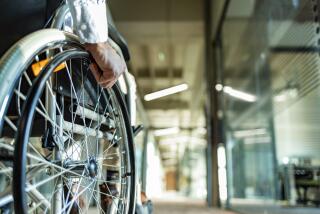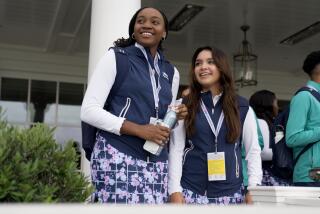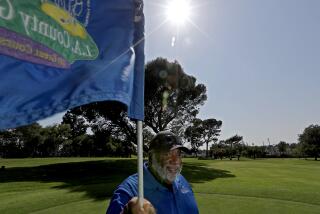Injured vets come out swinging
- Share via
SAN DIEGO — Army Sgt. Jerrod Fields, who lost his left leg to a roadside explosion in Baghdad in 2005, believes the trick to life is turning a temporary inconvenience into a permanent improvement.
With his prosthetic limb, the 26-year-old Fields has done that. He has become a champion sprinter and hopes to compete in the 2012 Paralympic Games in London.
On Tuesday, he was trying to learn yet another new skill: golf.
Fields was at Admiral Baker Golf Course here, being tutored by golf professionals as part of a two-day clinic under a program called “First Swing.” Organized by the Army and the National Amputee Golf Assn. with money from the U.S. Golf Assn., the goal is to help military personnel like Fields who have been wounded in combat.
“No wonder people break golf clubs,” Fields said jokingly. “It’s harder than you think.”
Golf instructors from several local military courses also came to Admiral Baker to learn from professionals who have worked with other injured personnel.
“Grip, posture, stance and alignment -- the fundamentals are the same whether you’re playing with only one arm or playing while sitting,” said Trace Kea, an Army civilian employee and PGA-certified instructor who was helping Fields.
A Department of Defense rule mandates that every military course have at least two golf carts with a seat that swivels and changes height to help golfers who have trouble standing. Admiral Baker has four, two for each of the 18-hole courses.
Tyler Monroe, golf instructor at the course at North Island Naval Air Station, practiced swinging with only one arm and standing on one leg to better understand the challenges of the injured athlete. On one leg, he sent a ball past the 150-yard marker with his 7-iron.
“You need to use new muscles,” he said.
Marty Ebel, 50, who lost both legs above the knee in a construction accident 20 years ago, now helps military personnel who’ve come back from the war zone. Many still have memories of the roadside bombs or other enemy attacks that left them injured.
“We’re hearing from guys back from Iraq and Afghanistan that they feel safe on the golf course,” he said. “I don’t think we can underestimate the importance of that.”
Ebel said he knows one golfer who lost both arms but tucks a club under his armpit. “He can hit a driver 220 yards. It’s amazing, just amazing,” he said.
After San Diego, the program moves on to military bases in Texas, Virginia, North Carolina, Kentucky, Washington and South Carolina.
Bob Wilson, 68, who lost both legs below the knee in an accident three decades ago aboard the carrier Kitty Hawk, runs the National Amputee Golf Assn. from his home in New Hampshire.
“Golf is a great rehabilitative sport,” Wilson said. “Somewhere between miniature golf and the Masters, there’s a niche out there for every disabled person who wants to play.”
--
--
Times staff photographer Don Bartletti contributed to this report.
More to Read
Sign up for Essential California
The most important California stories and recommendations in your inbox every morning.
You may occasionally receive promotional content from the Los Angeles Times.










